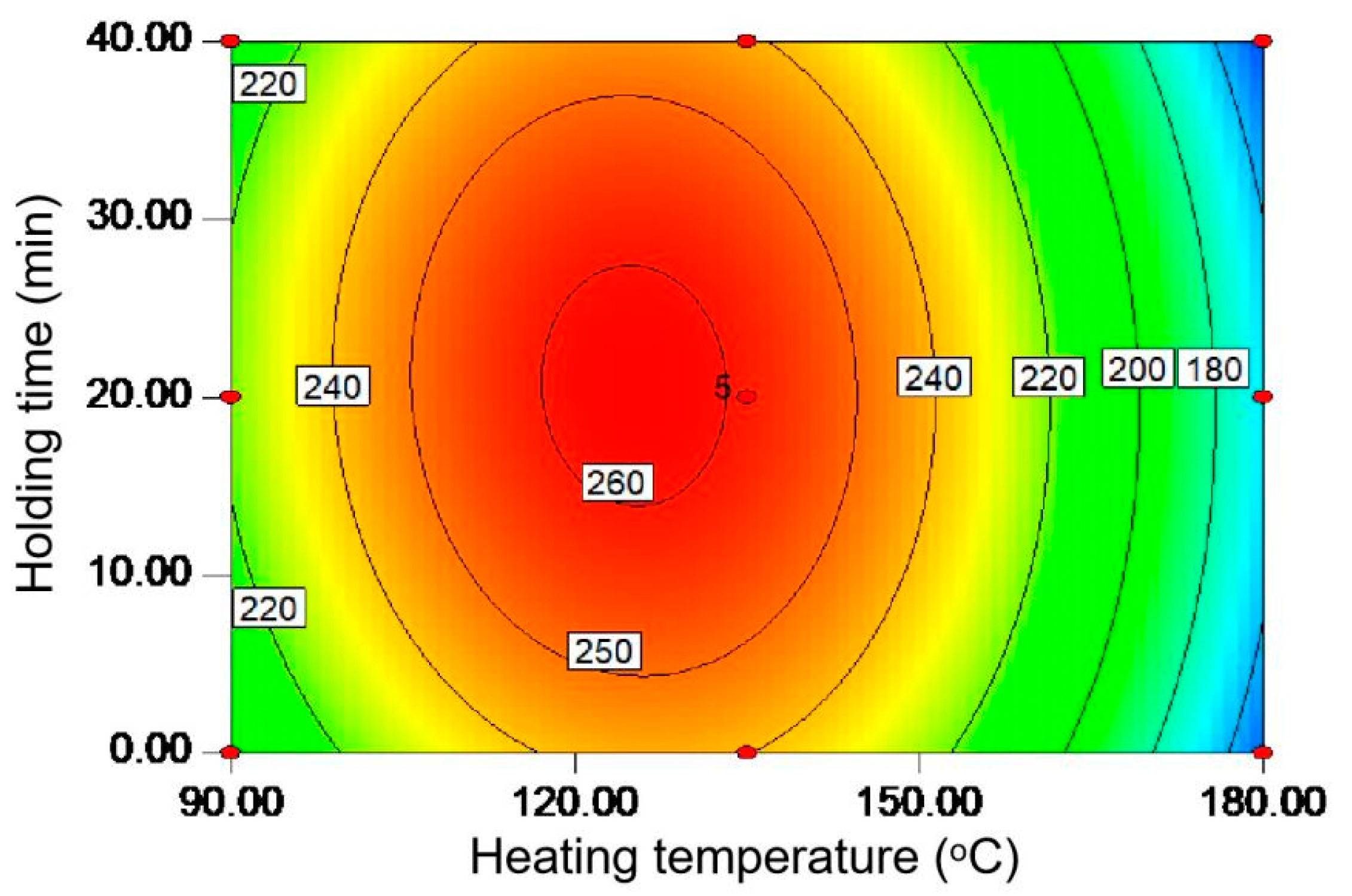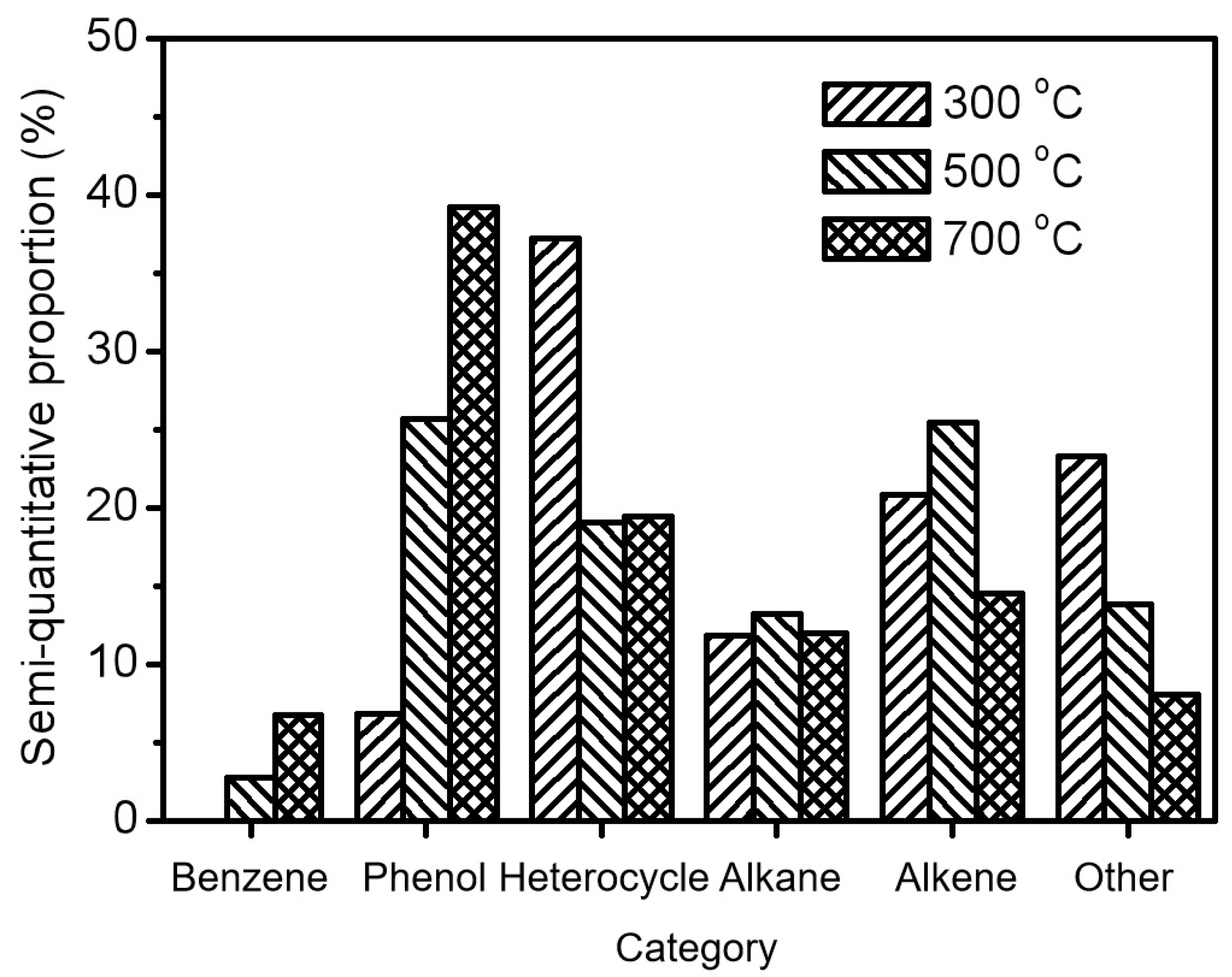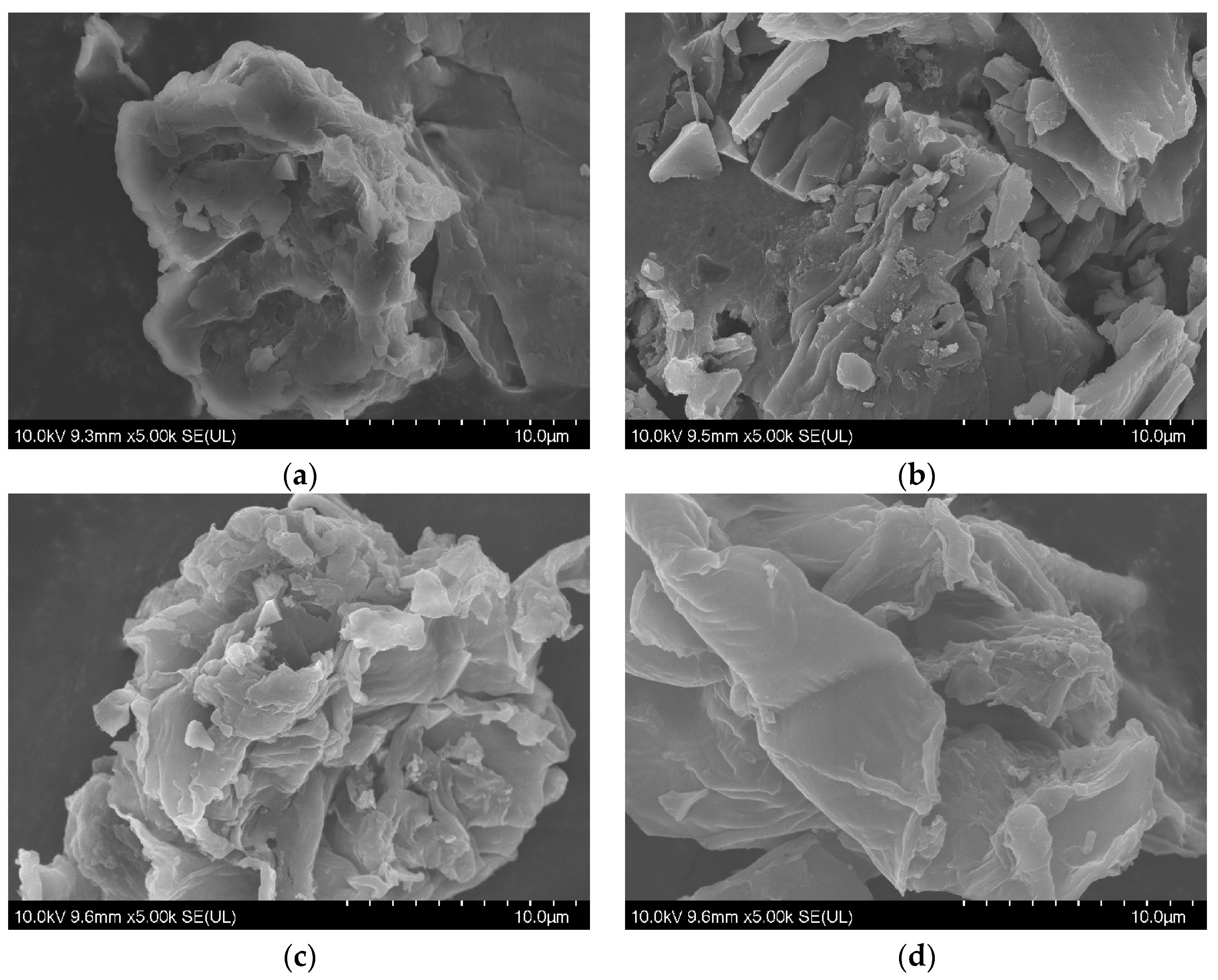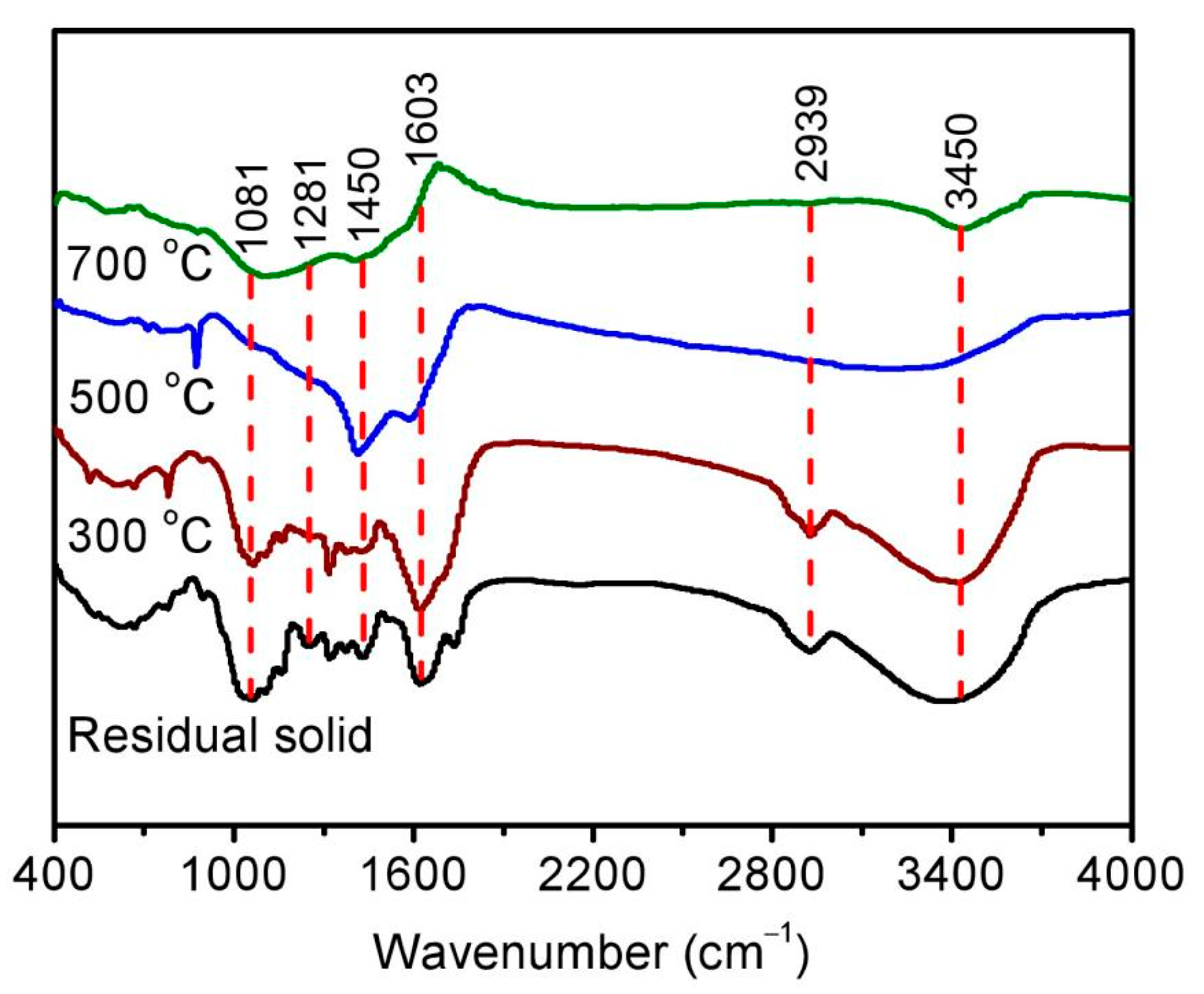Converting Tobacco Stalk Wastes into Value-Added Products via Sequential Hydrothermal and Pyrolysis Treatments
Abstract
:1. Introduction
2. Materials and Methods
2.1. Chemicals and Materials
2.2. Experimental Procedures
2.3. Analytical Methods
3. Results and Discussion
3.1. Pretreatment of Tobacco Stalks for Extracting Carbohydrates
3.2. Pyrolysis of Residual Solid for Producing Bio-Oil and Biochar
3.3. Application of Obtained Biochar for Removing Pollutant
4. Conclusions
Supplementary Materials
Author Contributions
Funding
Data Availability Statement
Conflicts of Interest
References
- Hatsukami, D.K.; Carroll, D.M. Tobacco harm reduction: Past history, current controversies and a proposed approach for the future. Prev. Med. 2020, 140, 106099. [Google Scholar] [CrossRef] [PubMed]
- Boettcher, R.; Zappe, A.L.; de Oliveira, P.F.; Machado, E.L.; Lawisch-Rodriguez, A.D.A.; Rodriguez-Lopez, D.A. Carbon footprint of agricultural production and processing of tobacco (Nicotiana tabacum) in southern Brazil. Environ. Technol. Innov. 2020, 18, 100625. [Google Scholar] [CrossRef]
- Ye, J.B.; Zheng, S.S.; Zhang, Z.; Yang, F.; Ma, K.; Feng, Y.J.; Zheng, J.Q.; Mao, D.B.; Yang, X.P. Bacterial cellulose production by Acetobacter xylinum ATCC 23767 using tobacco waste extract as culture medium. Bioresour. Technol. 2019, 274, 518–524. [Google Scholar] [CrossRef]
- He, J.T.; Yao, N.; Sun, Z.Y.; Li, F.; Cai, H.Q.; Jin, L.F.; Tang, Y.Q. Improved biogas production from tobacco processing waste via biochar-assisted thermophilic anaerobic digestion. Ind. Crops Prod. 2023, 202, 117038. [Google Scholar] [CrossRef]
- Banožić, M.; Babic, J.; Jokic, S. Recent advances in extraction of bioactive compounds from tobacco industrial waste-a review. Ind. Crops Prod. 2020, 144, 112009. [Google Scholar] [CrossRef]
- Faber, T.; Kumar, A.; Mackenbah, J.P.; Millett, C.; Basu, S.; Sheikh, A.; Been, J.V. Effect of tobacco control policies on perinatal and child health: A systematic review and meta-analysis. Lancet Public Health 2017, 2, e420–e437. [Google Scholar] [CrossRef]
- Luo, Y.P.; Fan, J.J.; Budarin, V.L.; Hu, C.W.; Clark, J.H. Microwave-assisted hydrothermal selective dissolution and utilisation of hemicellulose in Phyllostachys heterocycla cv. pubescens. Green Chem. 2017, 19, 4889–4899. [Google Scholar] [CrossRef]
- Lupatini, A.L.; Bispo, L.D.O.; Colla, L.M.; Costa, J.A.V.; Canan, C.; Colla, E. Protein and carbohydrate extraction from S. platensis biomass by ultrasound and mechanical agitation. Food Res. Int. 2017, 99, 1028–1035. [Google Scholar] [CrossRef]
- Wang, S.R.; Dai, G.X.; Yang, H.P.; Luo, Z.Y. Lignocellulosic biomass pyrolysis mechanism: A state-of-the-art review. Prog. Energy Combust. Sci. 2017, 62, 33–86. [Google Scholar] [CrossRef]
- Lin, Y.N.; Wang, C.; Yu, G.F.; Wang, H.Y.; Liang, R.N.; Kong, F.Y.; Song, D.A. Transformation of tobacco biomass into value-added carbohydrate, aromatics, and biochar. Biomass Convers. Bior. 2022, 14, 1–9, in press. [Google Scholar] [CrossRef]
- Meng, Q.L.; Yan, J.; Wu, R.Z.; Liu, H.Z.; Sun, Y.; Wu, N.N.; Xiang, J.F.; Zheng, L.R.; Zhang, J.; Han, B.X. Sustainable production of benzene from lignin. Nat. Commun. 2021, 12, 4534. [Google Scholar] [CrossRef] [PubMed]
- Shi, Z.; Ma, A.; Chen, Y.; Zhang, M.; Zhang, Y.; Zhou, N.; Fan, S.; Wang, Y. The removal of tetracycline from aqueous solutions using peanut shell biochars prepared at different pyrolysis temperatures. Sustainability 2023, 15, 874. [Google Scholar] [CrossRef]
- Zhang, X.K.; Zhang, W.W.; Lei, F.H.; Yang, S.J.; Jiang, J.X. Coproduction of xylooligosaccharides and fermentable sugars from sugarcane bagasse by seawater hydrothermal pretreatment. Bioresour. Technol. 2020, 309, 123385. [Google Scholar] [CrossRef] [PubMed]
- Yuan, Y.; Zhang, J.; Fan, J.J.; Clark, J.; Shen, P.L.; Li, Y.Q.; Zhang, C.S. Microwave assisted extraction of phenolic compounds from four economic brown macroalgae species and evaluation of their antioxidant activities and inhibitory effects on α-amylase, α-glucosidase, pancreatic lipase and tyrosinase. Food Res. Int. 2018, 113, 288–297. [Google Scholar] [CrossRef]
- Guo, X.H.; Fu, Y.J.; Miao, F.W.; Yu, Q.S.; Liu, N.; Zhang, F.S. Efficient separation of functional xylooligosaccharide, cellulose and lignin from poplar via thermal acetic acid/sodium acetate hydrolysis and subsequent kraft pulping. Ind. Crops Prod. 2020, 153, 112575. [Google Scholar] [CrossRef]
- Lopes, G.R.; Passos, C.P.; Rodrigues, C.; Teixeira, J.A.; Coimbra, M.A. Impact of microwave-assisted extraction on roasted coffee carbohydrates, caffeine, chlorogenic acids and coloured compounds. Food Res. Int. 2020, 129, 108864. [Google Scholar] [CrossRef] [PubMed]
- Jiang, Z.C.; Budarin, V.L.; Fan, J.J.; Remon, J.; Li, T.Z.; Hu, C.W.; Clark, J.H. Sodium chloride-assisted depolymerization of xylo-oligomers to xylose. ACS Sustain. Chem. Eng. 2018, 6, 4098–4104. [Google Scholar] [CrossRef]
- Yang, J.S.; Mu, T.H.; Ma, M.M. Optimization of ultrasound-microwave assisted acid extraction of pectin from potato pulp by response surface methodology and its characterization. Food Chem. 2019, 289, 351–359. [Google Scholar] [CrossRef]
- Melo, T.O.; Marques, F.A.; Hansel, F.A. Pyrolysis-gas chromatography-mass spectrometry Kováts retention index of pyrolysis products of lignocellulosic materials. J. Anal. Appl. Pyrolysis 2017, 126, 332–336. [Google Scholar] [CrossRef]
- Ettre, L.S. Retention index expressions. Chromatographia 2003, 58, 491–494. [Google Scholar] [CrossRef]
- Zhao, N.; Li, B.X. The effect of sodium chloride on the pyrolysis of rice husk. Appl. Energy 2016, 178, 346–352. [Google Scholar] [CrossRef]
- Li, C.; Sun, Y.F.; Dong, D.H.; Gao, G.G.; Zhang, S.; Wang, Y.; Xiang, J.; Hu, S.; Mortaza, G.; Hu, X. Co-pyrolysis of cellulose/lignin and sawdust: Influence of secondary condensation of the volatiles on characteristics of biochar. Energy 2021, 226, 120442. [Google Scholar] [CrossRef]
- Lee, T.; Jung, S.; Lin, K.Y.A.; Tsang, Y.F.; Kwon, E.E. Mitigation of harmful chemical formation from pyrolysis of tobacco waste using CO2. J. Hazard. Mater. 2021, 401, 123416. [Google Scholar] [CrossRef] [PubMed]
- Yan, B.C.; Zhang, S.P.; Chen, W.B.; Cai, Q.J. Pyrolysis of tobacco wastes for bio-oil with aroma compounds. J. Anal. Appl. Pyrolysis 2018, 136, 248–254. [Google Scholar] [CrossRef]
- Wang, W.L.; Wang, X.B.; Ma, Z.H.; Duan, C.; Liu, S.W.; Yu, H.L.; Li, X.P.; Cai, L.P.; Shi, S.Q.; Ni, Y.H. Breaking the lignin conversion bottleneck for multiple products: Co-production of aryl monomers and carbon nanospheres using one-step catalyst-free depolymerization. Fuel 2021, 285, 119211. [Google Scholar] [CrossRef]
- Guo, G.N.; Liu, X.; Li, R.; Li, Q.; Yu, H.B.; Li, M.J. Characterization of tobacco stalk lignin using nuclear magnetic resonance spectrometry and its pyrolysis behavior at different temperatures. J. Anal. Appl. Pyrolysis 2019, 142, 104665. [Google Scholar] [CrossRef]
- Guo, X.J.; Wang, S.R.; Guo, Z.G.; Liu, Q.; Luo, Z.Y.; Cen, K.F. Pyrolysis characteristics of bio-oil fractions separated by molecular distillation. Appl. Energy 2010, 87, 2892–2898. [Google Scholar] [CrossRef]
- Chen, Y.C.; Liu, J.T.; Zeng, Q.B.; Liang, Z.X.; Ye, X.X.; Lv, Y.C.; Liu, M.H. Preparation of Eucommia ulmoides lignin-based high-performance biochar containing sulfonic group: Synergistic pyrolysis mechanism and tetracycline hydrochloride adsorption. Bioresour. Technol. 2021, 329, 124856. [Google Scholar] [CrossRef]
- Chabi, N.; Baghdadi, M.; Sani, A.H.; Golzary, A.; Hosseinzadeh, M. Removal of tetracycline with aluminum boride carbide and boehmite particles decorated biochar derived from algae. Bioresour. Technol. 2020, 316, 123950. [Google Scholar] [CrossRef] [PubMed]
- Hoslett, J.; Ghazal, H.; Katsou, E.; Jouhara, H. The removal of tetracycline from water using biochar produced from agricultural discarded material. Sci. Total Environ. 2021, 751, 141755. [Google Scholar] [CrossRef]
- Xiang, W.; Wan, Y.S.; Zhang, X.Y.; Tan, Z.Z.; Xia, T.T.; Zheng, Y.L.; Gao, B. Adsorption of tetracycline hydrochloride onto ball-milled biochar: Governing factors and mechanisms. Chemosphere 2020, 255, 127057. [Google Scholar] [CrossRef] [PubMed]
- Cheng, D.L.; Ngo, H.H.; Guo, W.S.; Chang, S.W.; Nguyen, D.D.; Zhang, X.B.; Varjani, S.; Liu, Y. Feasibility study on a new pomelo peel derived biochar for tetracycline antibiotics removal in swine wastewater. Sci. Total Environ. 2020, 720, 137662. [Google Scholar] [CrossRef] [PubMed]
- Liu, W.J.; Jiang, H.; Yu, H.Q. Development of biochar-based functional materials: Toward a sustainable platform carbon material. Chem. Rev. 2015, 115, 12251–12285. [Google Scholar] [CrossRef] [PubMed]
- Song, D.A.; Cheng, H.Y.; Liu, R.P.; Qiang, Z.M.; He, H.; Liu, H.J.; Qu, J.H. Enhanced oxidation of tetracycline by permanganate via the alkali-induced alteration of the highest occupied molecular orbital and the electrostatic potential. Ind. Eng. Chem. Res. 2017, 56, 4703–4708. [Google Scholar] [CrossRef]
- Jiang, X.H.; Jefferson, W.A.; Song, D.A.; Cheng, H.Y.; Li, F.M.; Qiang, Z.M.; Zhang, A.Q.; Liu, H.J.; Qu, J.H. Regioselective oxidation of tetracycline by permanganate through alternating susceptible moiety and increasing electron donating ability. J. Environ. Sci. 2020, 87, 281–288. [Google Scholar] [CrossRef] [PubMed]
- Yazidi, A.; Atrous, M.; Soetaredjo, F.E.; Sellaoui, L.; Ismadji, S.; Erto, A.; Bonilla-Petriciolet, A.; Dotto, G.L.; Lamine, A.B. Adsorption of amoxicillin and tetracycline on activated carbon prepared from durian shell in single and binary systems: Experimental study and modeling analysis. Chem. Eng. J. 2020, 379, 122320. [Google Scholar] [CrossRef]
- Song, D.A.; Jiang, X.H.; Wang, D.B.; Fang, S.; Zhou, H.X.; Kong, F.Y. From the effective herbicide to the environmental contaminant: A review of recent studies on quinclorac. Environ. Exp. Bot. 2022, 193, 104706. [Google Scholar] [CrossRef]
- Velinov, N.; Mitrović, J.; Kostić, M.; Radović, M.; Petrović, M.; Bojić, D.; Bojić, A. Wood residue reuse for a synthesis of lignocellulosic biosorbent: Characterization and application for simultaneous removal of copper (II), Reactive Blue 19 and cyprodinil from water. Wood Sci. Technol. 2019, 53, 619–647. [Google Scholar] [CrossRef]
- Kostić, M.; Najdanović, S.; Velinov, N.; Vučić, M.R.; Petrović, M.; Mitrović, J.; Bojić, A. Ultrasound-assisted synthesis of a new material based on MgCoAl-LDH: Characterization and optimization of sorption for progressive treatment of water. Environ. Technol. Innov. 2022, 26, 102358. [Google Scholar] [CrossRef]
- Zhang, Z.L.; Li, Y.; Ding, L.; Yu, J.; Zhou, Q.; Kong, Y.L.; Ma, J.Y. Novel sodium bicarbonate activation of cassava ethanol sludge derived biochar for removing tetracycline from aqueous solution: Performance assessment and mechanism insight. Bioresour. Technol. 2021, 330, 124949. [Google Scholar] [CrossRef] [PubMed]
- Nguyen, V.T.; Nguyen, T.B.; Huang, C.P.; Chen, C.W.; Bui, X.T.; Dong, C.D. Alkaline modified biochar derived from spent coffee ground for removal of tetracycline from aqueous solutions. J. Water Process Eng. 2021, 40, 101908. [Google Scholar] [CrossRef]
- Wang, H.; Fang, C.; Wang, Q.; Chu, Y.; Song, Y.; Chen, Y.; Xue, X. Sorption of tetracycline on biochar derived from rice straw and swine manure. RSC Adv. 2018, 8, 16260–16268. [Google Scholar] [CrossRef] [PubMed]
- Yang, X.; Xu, G.; Yu, H.; Zhang, Z. Preparation of ferric-activated sludge-based adsorbent from biological sludge for tetracycline removal. Bioresour. Technol. 2016, 211, 566–573. [Google Scholar] [CrossRef] [PubMed]






Disclaimer/Publisher’s Note: The statements, opinions and data contained in all publications are solely those of the individual author(s) and contributor(s) and not of MDPI and/or the editor(s). MDPI and/or the editor(s) disclaim responsibility for any injury to people or property resulting from any ideas, methods, instructions or products referred to in the content. |
© 2024 by the authors. Licensee MDPI, Basel, Switzerland. This article is an open access article distributed under the terms and conditions of the Creative Commons Attribution (CC BY) license (https://creativecommons.org/licenses/by/4.0/).
Share and Cite
Lin, Y.; Yu, G.; Liang, R.; Kong, F.; Song, D. Converting Tobacco Stalk Wastes into Value-Added Products via Sequential Hydrothermal and Pyrolysis Treatments. Agronomy 2024, 14, 801. https://doi.org/10.3390/agronomy14040801
Lin Y, Yu G, Liang R, Kong F, Song D. Converting Tobacco Stalk Wastes into Value-Added Products via Sequential Hydrothermal and Pyrolysis Treatments. Agronomy. 2024; 14(4):801. https://doi.org/10.3390/agronomy14040801
Chicago/Turabian StyleLin, Yingnan, Guofeng Yu, Rongning Liang, Fanyu Kong, and Dean Song. 2024. "Converting Tobacco Stalk Wastes into Value-Added Products via Sequential Hydrothermal and Pyrolysis Treatments" Agronomy 14, no. 4: 801. https://doi.org/10.3390/agronomy14040801
APA StyleLin, Y., Yu, G., Liang, R., Kong, F., & Song, D. (2024). Converting Tobacco Stalk Wastes into Value-Added Products via Sequential Hydrothermal and Pyrolysis Treatments. Agronomy, 14(4), 801. https://doi.org/10.3390/agronomy14040801





